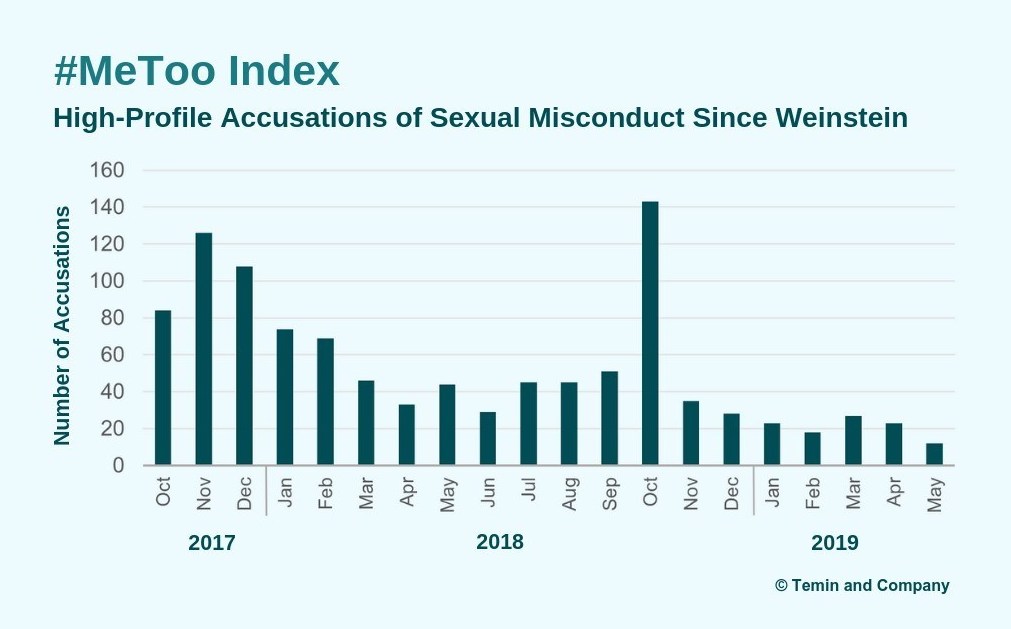According to the #MeToo Index, which tracks “high profile” incidents of sexual harassment, accusations have seemingly declined since Harvey Weinstein’s bad behaviors first surfaced in the media in October 2017, according to CBS News.

Is the drop in high profile accusations good news or bad news?
It could, of course, be good news if it’s a reflection of heightened awareness, better communication, and an increased response to employee complaints. But, CBS News suggests, it “could also reflect ongoing reluctance by many employees to report misconduct.”
Why the reluctance?
One of the primary reasons is the fear of retaliation at work. And, unfortunately, the fears may be justified.
Fear of Retaliation at Work is Justified
According to data from the EEOC, retaliation is the most frequently filed charge of job discrimination nationwide. Data from the fiscal year 2018, in fact, shows that retaliation claims are significantly higher than any other type of claim. Here are the top five:
- Retaliation: 39,469 (51.6% of all EEOC charges filed)
- Sex: 24,655 (32.3%)
- Disability: 24,605 (32.2%)
- Race: 24,600 (32.2%)
- Age: 16,911 (22.1%)
Given these statistics, it is not terribly surprising that employees are anxious about what might happen to them if they report misconduct or concerns at work. Indeed, these fears of retaliation are so strong that they can exist—and prevent reporting—even when they are not actually justified in a particular workplace.
So while employees are protected from retaliation under the law in theory, in practice their fear of retaliation in the workplace and the potential impact it could have on their jobs and careers keep many from stepping forward. That may be the case even in environments that stress and support transparency and encourage reporting.
What Is Retaliation In the Workplace?
According to the EEOC, it is illegal for organizations to retaliate against employees or applicants for engaging in certain legally protected activities. These activities include:
- Filing or being a witness in an EEO charge, complaint, investigation, or lawsuit
- Communicating with a supervisor or manager about employment discrimination, including harassment
- Answering questions during an employer investigation of alleged harassment
- Refusing to follow orders that would result in discrimination
- Resisting sexual advances, or intervening to protect others
- Requesting accommodation of a disability or for a religious practice
- Asking managers or coworkers about salary information to uncover potentially discriminatory wages
This list isn’t all-inclusive. As the EEOC states: “Other acts to oppose discrimination are protected as long as the employee was acting on a reasonable belief that something in the workplace may violate EEO laws, even if he or she did not use legal terminology to describe it.”
A strong case of retaliation need not involve egregious or immediate punitive action, according to the EEOC. It occurs, they say, “when an employer takes a materially adverse action because an applicant or employee asserts rights protected by the EEO laws.” The term “materially adverse” has been interpreted broadly to include any employer response that “might well deter a reasonable employee from complaining about discrimination,” although minor actions such as “petty slights, minor annoyances, and simple lack of good manners” would not be sufficient to establish retaliation.
What types of retaliation are employees typically concerned about? Removal from key initiatives or projects; loss of advancement opportunities; negative performance reviews; hour and wage cuts; forced relocation, shift change, or transfer—even termination.
Easing Retaliation Fears
Because the definition of retaliation is a bit vague, and there are sufficient business reasons for certain negative actions, both employees and managers should receive clear guidance through policies and training about what retaliation is, how it can—and should—be avoided, and the legal and organizational consequences for its occurrence. .
In addition, managers must also be educated on how to appropriately address employee concerns and how to protect against reprisal—intentional or inadvertent—after an employee engages in protected activity. Combining these education efforts with a focus on building a positive workplace and creating a climate where employees feel safe coming forward with concerns will help avoid many issues altogether.
Establishing an environment where employees will feel free to raise issues and concerns without fear of retaliation in the workplace requires a combination of communication, education, and action. Here are a few tips:
- Ensure that all staff—employees, and managers—understand what constitutes retaliation and the organization’s policy against it. Communicate and educate to ensure understanding and create an open, two-way channel of communication.
- Review policies to ensure they encourage employees to come forward and impose serious consequences for those who commit retaliation.
- Train supervisors and managers on how to appropriately respond to any issues that are brought to their attention.
- Take visible action when reported concerns are supported by evidence. While the specifics of each situation may be subject to privacy and confidentiality restrictions, general statements to the person who filed a report, witnesses, and others affected can be made that make it clear to employees that appropriate action was taken as a result of the report. This kind of transparency can go far to alleviate employee concerns about raising issues.
It will take time to establish an environment where employees are confident that they will be free from retaliation when bringing issues forward to management or HR. Most importantly, not only what you say but what you do will help alleviate the fear of retaliation in the workplace.
Keep in mind that, if your efforts are successful, reported incidents may rise. Unlike what we may be seeing in the aftermath of Harvey Weinstein’s high-profile harassment accusations, your efforts to create a retaliation-free environment may actually lead to more reports of concerns, at least initially. This should be interpreted as a vote of confidence in your organization and, ultimately, can lead to a positive turnaround.

